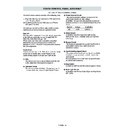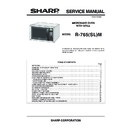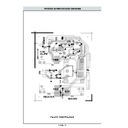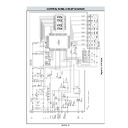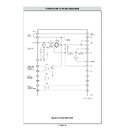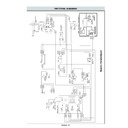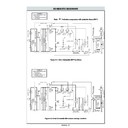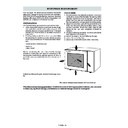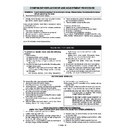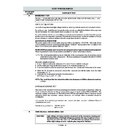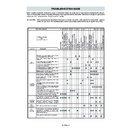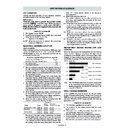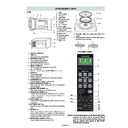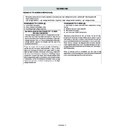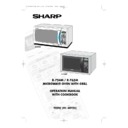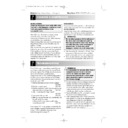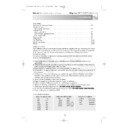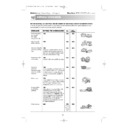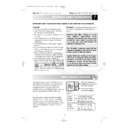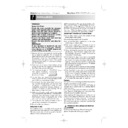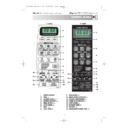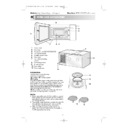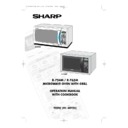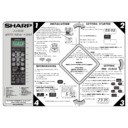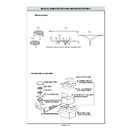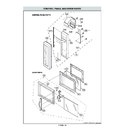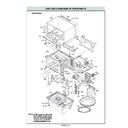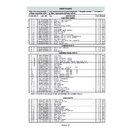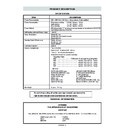Sharp R-765M (serv.man8) Service Manual ▷ View online
R-765M - 16
The touch control section consists of the following units.
(1) Key Unit (The key unit consists of a FPC membrane
and a Graphic sheet.)
(2) Control Unit (The Control Unit consists of Power
Unit and CPU Unit).
The principal functions of these units and the signals
communicated among them are explained below.
communicated among them are explained below.
Key Unit
The key unit is composed of a matrix, signals generated
in the LSI are sent to the key unit through P20, P21,
P22, P23, P24, P25, P26 and P27.
When a key pad is touched, a signal is completed
through the key unit and passed back to the LSI
through P43, P44, P45 and P46 to perform the function
that was requested.
The key unit is composed of a matrix, signals generated
in the LSI are sent to the key unit through P20, P21,
P22, P23, P24, P25, P26 and P27.
When a key pad is touched, a signal is completed
through the key unit and passed back to the LSI
through P43, P44, P45 and P46 to perform the function
that was requested.
Control Unit
Control unit consists of LSI, ACL circuit, indicator circuit,
power source circuit, relay circuit, buzzer circuit,
synchronizing signal circuit and back light circuit.
Control unit consists of LSI, ACL circuit, indicator circuit,
power source circuit, relay circuit, buzzer circuit,
synchronizing signal circuit and back light circuit.
1) ACL
This circuit generates a signal which resets the LSI
to the initial state when power is supplied.
to the initial state when power is supplied.
2) Indicator Circuit
This circuit consists of 4-digits, 12-segments and 3
common electrodes using a Liquid Crystal Display.
common electrodes using a Liquid Crystal Display.
TOUCH CONTROL PANEL ASSEMBLY
OUTLINE OF TOUCH CONTROL PANEL
3) Power Source Circuit
This circuit generates voltages necessary in the
control unit from the AC line voltage.
In addition, the synchronizing signal is available in
order to compose a basic standard time in the clock
circuit.
control unit from the AC line voltage.
In addition, the synchronizing signal is available in
order to compose a basic standard time in the clock
circuit.
Symbol
Voltage
Application
VC
-5.2V
LSI(IC1)
4) Relay Circuit
A circuit to drive the magnetron, grill heating
element, fan motor, turntable motor and light the
oven lamp.
element, fan motor, turntable motor and light the
oven lamp.
5) Buzzer Circuit
The buzzer is responsive to signals from the LSI to
emit audible sounds (key touch sound and
completion sound).
emit audible sounds (key touch sound and
completion sound).
6) Synchronizing Signal Circuit
The power source synchronizing signal is available
in order to compose a basic standard time in the
clock circuit.
It accompanies a very small error because it works
on commercial frequency.
in order to compose a basic standard time in the
clock circuit.
It accompanies a very small error because it works
on commercial frequency.
7) Stop Switch
A switch to “tell” the LSI if the door is open or closed.
8) Back Light Circuit
A circuit to drive the back light (Light emitting diodes
LD1- LD5).
LD1- LD5).
R-765M - 17
1-2
VL2-VL1
IN
Power source voltage input terminal.
Standard voltage for LCD.
Standard voltage for LCD.
3-6
AN7-AN4
IN
Terminal to change functions according to the Model.
By using the A/D converter contained in the LSI, DC voltage in accordance with
the Model in operation is applied to set up its functions.
By using the A/D converter contained in the LSI, DC voltage in accordance with
the Model in operation is applied to set up its functions.
7-8
P63-P62
OUT
Terminal not used.
9
AN1
IN
To input signal which communicates the door open/close information to LSI.
Door close "H" level signal (0V). Door open "L" level signal (-5V).
Door close "H" level signal (0V). Door open "L" level signal (-5V).
10
P60
OUT
Terminal not used.
11-13
P57-P55
OUT
Terminal not used.
14
CNTR0
OUT
Signal to sound buzzer (2.0 kHz).
A: key touch sound.
B: Completion sound.
A: key touch sound.
B: Completion sound.
15
P53
OUT
Oven lamp, fan motor and turntable motor driving signal
To turn on and off shut off relay (RY1).
The square waveform voltage is
delivered to the RY1 driving circuit, RY2
and RY3 control circuit.
To turn on and off shut off relay (RY1).
The square waveform voltage is
delivered to the RY1 driving circuit, RY2
and RY3 control circuit.
16
P52
OUT
Magnetron high-voltage circuit driving signal.
To turn on and off the cook relay (RY3).
The signals holds "L" level during
microwave cooking and "H" level while
not cooking. In other cooking modes
(variable cooking) the signal turns to "H"
level and "L" level in repetition according
to the power level.
To turn on and off the cook relay (RY3).
The signals holds "L" level during
microwave cooking and "H" level while
not cooking. In other cooking modes
(variable cooking) the signal turns to "H"
level and "L" level in repetition according
to the power level.
(ON and OFF times for other power level.)
17
P51
OUT
Grill heating element driving signal
To turn on and off the grill heating element
relay (RY2). "L" level during grill cooking
or dual cooking; "H" level otherwise.
To turn on and off the grill heating element
relay (RY2). "L" level during grill cooking
or dual cooking; "H" level otherwise.
18
P50
OUT
Terminal not used.
19
P47
OUT
Terminal not used.
20
P46
IN
Signal coming from touch key.
When either G12 line on key matrix is touched, a corresponding signal out of P20
- P27 will be input into P46. When no key is touched, the signal is held at "H" level.
When either G12 line on key matrix is touched, a corresponding signal out of P20
- P27 will be input into P46. When no key is touched, the signal is held at "H" level.
21
P45
IN
Signal similar to P46.
When either G11 line on key matrix is touched, a corresponding signal will be input
into P45.
When either G11 line on key matrix is touched, a corresponding signal will be input
into P45.
22
P44
IN
Signal similar to P46.
When either G10 line on key matrix is touched, a corresponding signal will be input
into P44.
When either G10 line on key matrix is touched, a corresponding signal will be input
into P44.
23
P43
IN
Signal similar to P46.
When either G9 line on key matrix is touched, a corresponding signal will be input
into P43.
When either G9 line on key matrix is touched, a corresponding signal will be input
into P43.
24
INT0
IN
Signal synchronized with commercial power source frequency.
This is the basic timing for time processing of LSI.
This is the basic timing for time processing of LSI.
25
P41
OUT
Terminal not used.
26
P40
IN
Connected to VC through the pull-down resistor R90.
27
RESET
IN
Auto clear terminal.
Signal is input to reset the LSI to the initial state when power is applied. Temporarily set "L"
level the moment power is applied, at this time the LSI is reset. Thereafter set at "H" level.
Signal is input to reset the LSI to the initial state when power is applied. Temporarily set "L"
level the moment power is applied, at this time the LSI is reset. Thereafter set at "H" level.
DESCRIPTION OF LSI
LSI(IXA083DR)
The I/O signal of the LSI(IXA083DR) are detailed in the following table.
The I/O signal of the LSI(IXA083DR) are detailed in the following table.
Pin No.
Signal
I/O
Description
A
B
0.12 sec.
2.4 sec.
H : GND
L : -5V
H : GND
L : -5V
20.0 msec.
During cooking
H : GND
L : -5V
100P
H : GND
L : -5V
H : GND
L : -5V
70P
ON
ON
OFF
OFF
OFF
24 sec.
8 sec.
(Grill or dual)
ON
OFF
During
cooking
L
GND
H.
R-765M - 18
28-29
P71-P70
OUT
Terminal not used.
30
XIN
IN
Internal clock oscillation frequency input setting.
The internal clock frequency is set by inserting the ceramic filter oscillation circuit
with respect to XOUT terminal.
The internal clock frequency is set by inserting the ceramic filter oscillation circuit
with respect to XOUT terminal.
31
XOUT
OUT
Internal clock oscillation frequency control output.
Output to control oscillation input of XIN.
Output to control oscillation input of XIN.
32
VSS
IN
Power source voltage: -5.0V.
VC voltage of power source circuit input.
VC voltage of power source circuit input.
33
P27
OUT
Key strobe signal.
Signal applied to touch-key section. A pulse signal is input to P43, P44, P45 and
P46 terminal while one of G1 line keys on key matrix is touched.
Signal applied to touch-key section. A pulse signal is input to P43, P44, P45 and
P46 terminal while one of G1 line keys on key matrix is touched.
34
P26
OUT
Key strobe signal.
Signal applied to touch-key section. A pulse signal is input to P43, P44, P45 and
P46 terminal while one of G2 line keys on key matrix is touched.
Signal applied to touch-key section. A pulse signal is input to P43, P44, P45 and
P46 terminal while one of G2 line keys on key matrix is touched.
35
P25
OUT
Key strobe signal.
Signal applied to touch-key section. A pulse signal is input to P43, P44, P45 and
P46 terminal while one of G3 line keys on key matrix is touched.
Signal applied to touch-key section. A pulse signal is input to P43, P44, P45 and
P46 terminal while one of G3 line keys on key matrix is touched.
36
P24
OUT
Key strobe signal.
Signal applied to touch-key section. A pulse signal is input to P43, P44, P45 and
P46 terminal while one of G4 line keys on key matrix is touched.
Signal applied to touch-key section. A pulse signal is input to P43, P44, P45 and
P46 terminal while one of G4 line keys on key matrix is touched.
37
P23
OUT
Key strobe signal.
Signal applied to touch-key section. A pulse signal is input to P43, P44, P45 and
P46 terminal while one of G5 line keys on key matrix is touched.
Signal applied to touch-key section. A pulse signal is input to P43, P44, P45 and
P46 terminal while one of G5 line keys on key matrix is touched.
38
P22
OUT
Key strobe signal.
Signal applied to touch-key section. A pulse signal is input to P43, P44, P45 and
P46 terminal while one of G6 line keys on key matrix is touched.
Signal applied to touch-key section. A pulse signal is input to P43, P44, P45 and
P46 terminal while one of G6 line keys on key matrix is touched.
39
P21
OUT
Key strobe signal.
Signal applied to touch-key section. A pulse signal is input to P43, P44, P45 and
P46 terminal while one of G7 line keys on key matrix is touched.
Signal applied to touch-key section. A pulse signal is input to P43, P44, P45 and
P46 terminal while one of G7 line keys on key matrix is touched.
40
P20
OUT
Key strobe signal.
Signal applied to touch-key section. A pulse signal is input to P43, P44, P45 and
P46 terminal while one of G8 line keys on key matrix is touched.
Signal applied to touch-key section. A pulse signal is input to P43, P44, P45 and
P46 terminal while one of G8 line keys on key matrix is touched.
41-56
P17-P00
OUT
Terminal not used.
57-60
P37-P34
OUT
Terminal not used.
61-72
SEG11-SEG0
OUT
Segment data signal.
Connected to LCD.
The relation between signals are as follows:
Connected to LCD.
The relation between signals are as follows:
LSI signal (Pin No.) LCD segment
LSI signal (Pin No.) LCD segment
SEG 11 (61) ............................ S12
SEG 5 (67) .............................. S6
SEG 10 (62) ............................ S11
SEG 4 (68) .............................. S5
SEG 9 (63) ............................ S10
SEG 3 (69) .............................. S4
SEG 8 (64) ............................ S9
SEG 2 (70) .............................. S3
SEG 7 (65) ............................ S8
SEG 1 (71) .............................. S2
SEG 6 (66) ............................ S7
SEG 0 (72) .............................. S1
73/74
VCC/VREF
IN
Connected to GND.
75
AVSS
IN
Connected to VC.
76
COM3
OUT
Terminal not used.
77
COM2
OUT
Common data signal.
Connected to LCD signal C3.
Connected to LCD signal C3.
78
COM1
OUT
Common data signal.
Connected to LCD signal C2.
Connected to LCD signal C2.
79
COM0
OUT
Common data signal.
Connected to LCD signal C1.
Connected to LCD signal C1.
80
VL3
IN
Power source voltage input terminal.
Standard voltage for LCD.
Pin No.
Signal
I/O
Description
DESCRIPTION OF LSI
LSI(IXA083DR)
The I/O signal of the LSI(IXA083DR) are detailed in the following table.
The I/O signal of the LSI(IXA083DR) are detailed in the following table.
R-765M - 19
1. Precautions for Handling Electronic Components
This unit uses CMOS LSI in the integral part of the
circuits. When handling these parts, the following pre-
cautions should be strictly followed. CMOS LSI have
extremely high impedance at its input and output
terminals. For this reason, it is easily influenced by the
surrounding high voltage power source, static electric-
ity charge in clothes, etc., and sometimes it is not fully
protected by the built-in protection circuit.
In order to protect CMOS LSI.
1) When storing and transporting, thoroughly wrap
circuits. When handling these parts, the following pre-
cautions should be strictly followed. CMOS LSI have
extremely high impedance at its input and output
terminals. For this reason, it is easily influenced by the
surrounding high voltage power source, static electric-
ity charge in clothes, etc., and sometimes it is not fully
protected by the built-in protection circuit.
In order to protect CMOS LSI.
1) When storing and transporting, thoroughly wrap
them in aluminium foil. Also wrap PW boards con-
taining them in aluminium foil.
taining them in aluminium foil.
2) When soldering, ground the technician as shown in
the figure and use grounded soldering iron and
work table.
work table.
2. Servicing of Touch Control Panel
We describe the procedures to permit servicing of the
touch control panel of the microwave oven and the
precautions you must take when doing so.
To perform the servicing, power to the touch control
panel is available either from the power line of the oven
itself or from an external power source.
(1) Servicing the touch control panel with power
touch control panel of the microwave oven and the
precautions you must take when doing so.
To perform the servicing, power to the touch control
panel is available either from the power line of the oven
itself or from an external power source.
(1) Servicing the touch control panel with power
supply of the oven :
CAUTION:
THE HIGH VOLTAGE TRANSFORMER OF THE
MICROWAVE OVEN IS STILL LIVE DURING
SERVICING AND PRESENTS A HAZARD .
Therefore, when checking the performance of the
touch control panel, put the outer cabinet on the
oven to avoid touching the high voltage trans-
former, or unplug the primary terminal (connector)
of the high voltage transformer to turn it off; the end
of such connector must be insulated with an insulat-
ing tape. After servicing, be sure to replace the
leads to their original locations.
A. On some models, the power supply cord be-
CAUTION:
THE HIGH VOLTAGE TRANSFORMER OF THE
MICROWAVE OVEN IS STILL LIVE DURING
SERVICING AND PRESENTS A HAZARD .
Therefore, when checking the performance of the
touch control panel, put the outer cabinet on the
oven to avoid touching the high voltage trans-
former, or unplug the primary terminal (connector)
of the high voltage transformer to turn it off; the end
of such connector must be insulated with an insulat-
ing tape. After servicing, be sure to replace the
leads to their original locations.
A. On some models, the power supply cord be-
tween the touch control panel and the oven itself
is so short that the two can't be separated.
For those models, check and repair all the
controls (sensor-related ones included) of the
touch control panel while keeping it connected
to the oven.
is so short that the two can't be separated.
For those models, check and repair all the
controls (sensor-related ones included) of the
touch control panel while keeping it connected
to the oven.
B. On some models, the power supply cord be-
tween the touch control panel and the oven is so
long enough that they may be separated from
each other.
long enough that they may be separated from
each other.
For those models, therefore, it is possible to check
and repair the controls of the touch control panel
while keeping it apart from the oven; in this case
you must short both ends of the door sensing
switch (on PWB) of the touch control panel with
a jumper, which brings about an operational
while keeping it apart from the oven; in this case
you must short both ends of the door sensing
switch (on PWB) of the touch control panel with
a jumper, which brings about an operational
SERVICING
state that is equivalent to the oven door being
closed. As for the sensor-related controls of the
touch control panel, checking them is possible if
the dummy resistor(s) with resistance equal to
that of the controls are used.
closed. As for the sensor-related controls of the
touch control panel, checking them is possible if
the dummy resistor(s) with resistance equal to
that of the controls are used.
(2) Servicing the touch control panel with power
supply from an external power source:
Disconnect the touch control panel completely from
the oven, and short both ends of the door sensing
switch (on PWB) of the touch control panel, which
brings about an operational state that is equivalent
to the oven door being closed. Connect an external
power source to the power input terminal of the
touch control panel, then it is possible to check and
repair the controls of the touch control panel; it is
also possible to check the sensor-related controls
of the touch control panel by using the dummy
resistor(s).
Disconnect the touch control panel completely from
the oven, and short both ends of the door sensing
switch (on PWB) of the touch control panel, which
brings about an operational state that is equivalent
to the oven door being closed. Connect an external
power source to the power input terminal of the
touch control panel, then it is possible to check and
repair the controls of the touch control panel; it is
also possible to check the sensor-related controls
of the touch control panel by using the dummy
resistor(s).
3. Servicing Tools
Tools required to service the touch control panel as-
sembly.
1) Soldering iron: 30W
sembly.
1) Soldering iron: 30W
(It is recommended to use a soldering iron with a
grounding terminal.)
grounding terminal.)
2) Oscilloscope: Single beam, frequency range: DC -
10MHz type or more advanced model.
3) Others: Hand tools
4. Other Precautions
1) Before turning on the power source of the control
unit, remove the aluminium foil applied for prevent-
ing static electricity.
ing static electricity.
2) Connect the connector of the key unit to the control
unit being sure that the lead wires are not twisted.
3) After aluminium foil is removed, be careful that
abnormal voltage due to static electricity etc. is not
applied to the input or output terminals.
applied to the input or output terminals.
4) Attach connectors, electrolytic capacitors, etc. to
PWB, making sure that all connections are tight.
5) Be sure to use specified components where high
precision is required.
approx. 1M ohm
Display

